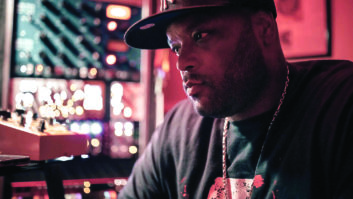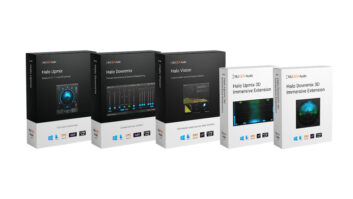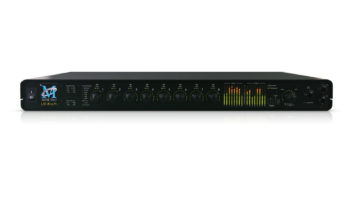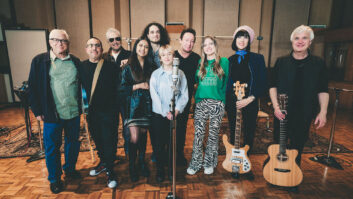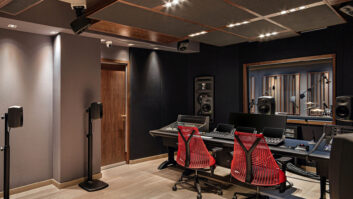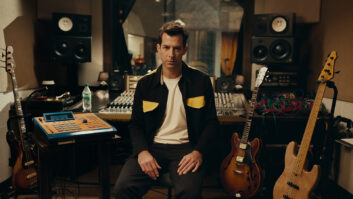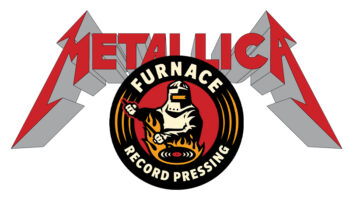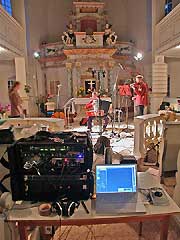
For his new album of solo instrumental music, Celtic harp player Ralf Kleemann relied on a minimal recording rig that integrated Metric Halo’s Mobile I/O 2882 interface with nothing more than a laptop computer, a handful of microphones and a couple of preamps. Although the recordings for Kleemann’s second solo album of all-original material, Tides, were made in the living room of his house in Cork, Ireland, his pristine mobile recording setup and attention to detail have led many listeners to believe they were recorded in a high-end studio.
Four neutral-sounding microphones were recorded to an Apple PowerBook running Logic Pro 7 in a series of nightly performances, timed to minimize city noise such as traffic. Comments Kleemann, “The MIO 2882 translated the tiniest detail of the sound and performed flawlessly throughout the project, even though my PowerBook was running a savage combination of beta and whatever other software on a 10.3.x installation that had been operating nearly 24/7 for quite some time.
“My idea was to record the Celtic harp as faithfully as possible and to give it a good, vibrant room sound because, when close-miking, harps tend to sound thin with a boomy low end,” he continues. “And, after all, the audience in a concert don’t stick their ears directly onto the harp, but sit in a room in which the instrument can interact.
“I used [Metric Halo’s SpectraFoo] to measure the room response and identify potential problems such as bass peaks or reflections relating to the microphone positions. I also tried to get a grip on the room sound itself, trying to visualize why it sounded so good. Basically, I think it was because of the irregular reflections due to the room shape. I was also able to dampen certain reflections and bass peaks by rearranging the interior. Apart from that, SpectraFoo is a very powerful tool for all sorts of audio analysis, and with my work, I’ve barely scratched the surface of what it can do.”
Kleeman used two AKG C414B-XLS mics in omni mode for the stereo pair, in a spaced, baffled A/B array with about 30cm distance. These went into a Hamptone HJFP2 preamp. The second pair comprised an X-Y array of two AKG C391B cardioid microphones, later mixed to mono and used as a spot microphone to catch some of the finer details close to the instrument. These went into an LA Audio MLX20 preamp.

The setup provided a sense of space, while also capturing the nuances of the instrument. “It was nice to have some ‘stereo-esque’ early reflections,” he explains, “while the closer pair provided a finer level of detail. I used two external preamps for some extra seasoning, although the internal ones would have done the job just as nicely. It’s a matter of taste.”
The mixing process was equally streamlined, he reports. “I followed a minimalist approach when mixing, compensating for the distance between the mics, some volume changes and a small bit of linear phase EQ to get rid of faint city noises in the distance, as well as to tame one note of the instrument that sounded boomy. I also added a tail of IR reverb for some spaciousness. Other than that, there was no processing: no compressor, no limiter, no nothing. Thus, the recording maintains much of the original dynamics and simply sounds real.
“The levels were contained by manually riding the volume controls, and no automatic limiting, let alone compression, was applied. I decided to follow this road in the interest of purity, as I want to allow the music to retain its natural breath, placing the audience as close as possible to where the original music was played.”
Before sending the master to be duplicated, Kleemann consulted with mastering engineer Bob Katz to confirm that his approach made real-world sense, he says. “His hints and suggestions were vital for turning the mix into the final version, chiefly because he supported my assumption that there is no reason to make up, fake up a pure, natural recording.”
With the finished disc now available, Kleeman adds, “The feedback I have received so far has been very encouraging. People have been asking in which high-end studio the recordings were done. I take that as confirmation that I made exactly the right choices when I picked my equipment. I’m looking forward to the next project!”
For more information on Kleeman, visit www.kleeworld.com. For more information on Metric Halo, visit www.mhlabs.com.
